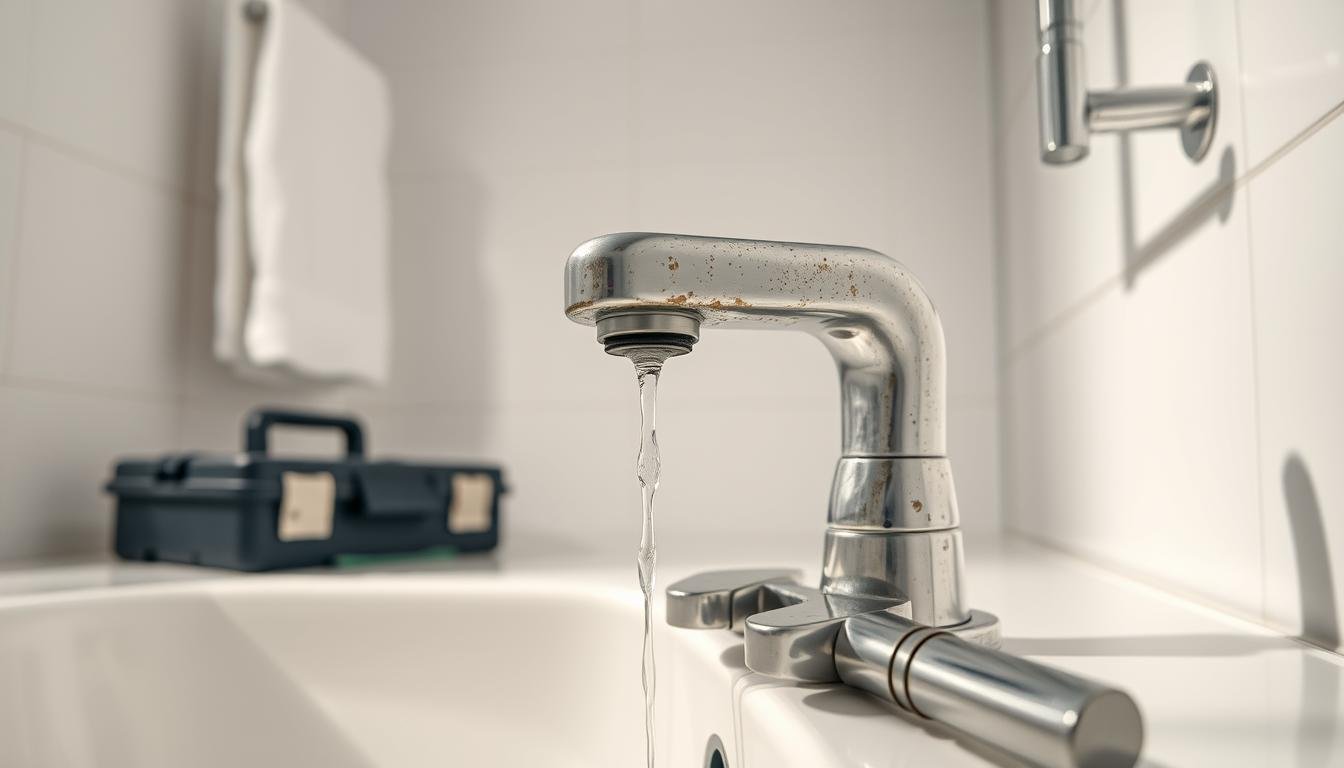A leaky faucet is more than a hassle; it can waste a lot of water and raise your bills. Did you know a single drip can waste up to 20 gallons of water per day? Fixing it is good for the planet and your wallet.
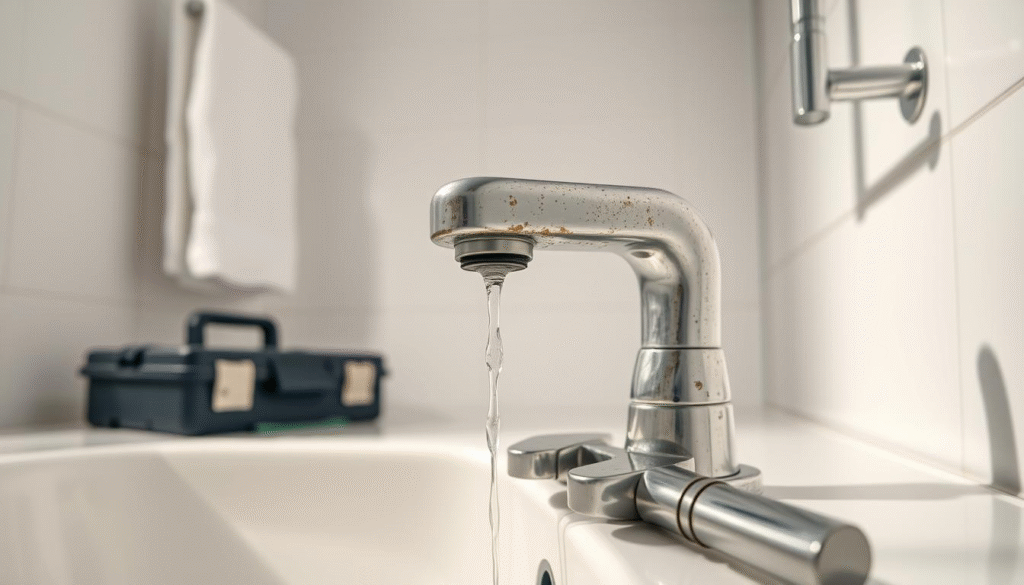
The average cost for leaky faucet repair is $169. Most people spend between $70 and $300. The price changes based on the faucet type, repair complexity, and plumber’s fees.
Key Takeaways
- The average leaky faucet repair cost is $169.
- Repair costs typically range between $70 and $300.
- The type of faucet and complexity of the repair affect the cost.
- Hiring a professional plumber can impact the overall cost.
- Fixing a leaky faucet can save water and reduce utility bills.
Understanding the Impact of a Leaky Faucet
A leaky faucet does more than just drip water. It affects the environment and your home’s structure. If not fixed, it can cause big problems.
Water Waste and Environmental Concerns
A faucet that drips one drop per second wastes over 3,000 gallons of water each year. This is what the U.S. Environmental Protection Agency says. It not only uses up water but also raises your water bill. It’s important to fix leaks quickly for the planet’s sake.
Potential Damage to Your Home
Leaky faucets can harm your home. They can damage countertops and floors with water. If you ignore it, moisture can cause mold, making things worse. Fixing it fast is key to avoid damage.
Long-Term Cost Implications of Ignoring Leaks
Not fixing a leaky faucet can cost you more in the long run. It can lead to higher water bills and expensive repairs. Fixing it early can save you money and hassle.
| Issue | Short-Term Impact | Long-Term Impact |
| Water Waste | Increased water bill | Strained water resources |
| Home Damage | Water damage to surfaces | Mold growth and structural issues |
| Cost Implications | Higher utility bills | Expensive repairs and possible replacements |
Common Causes of Leaky Faucets
Leaky faucets are a common problem in homes. They can come from many causes. Knowing these causes helps fix the issue and stop future leaks.
Worn-Out O-Rings and Washers
Worn-out O-rings and washers often cause leaks. These parts wear out from constant use. Replacing them is easy and can save money.
The average cost to fix a leaky faucet goes down when you fix these parts.
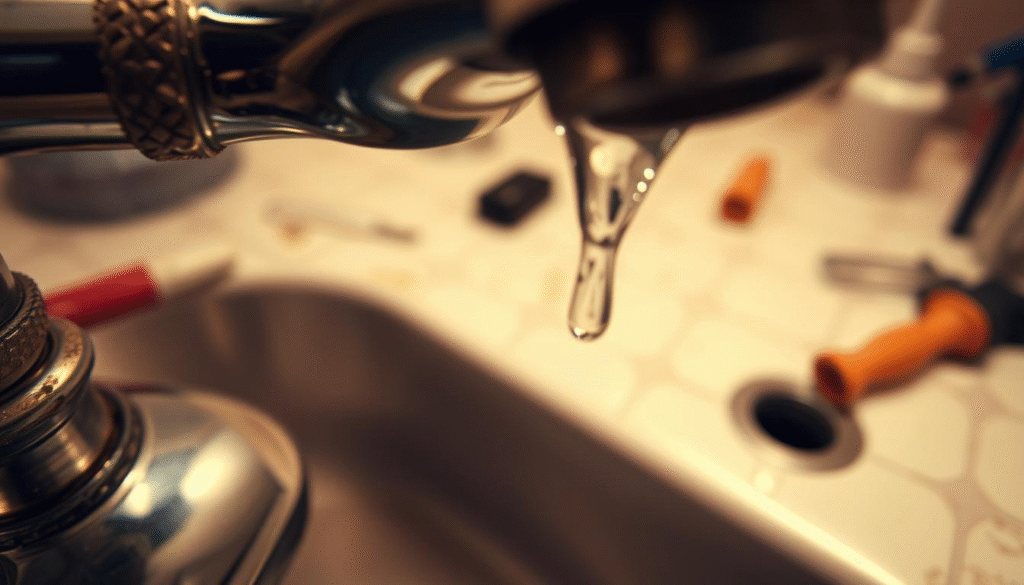
Corroded Valve Seats
Corrosion of valve seats is another big reason for leaks. When valve seats corrode, they can’t connect right. This leads to leaks. Keeping up with maintenance can stop this problem.
Loose Parts and Connections
Loose parts or connections inside the faucet can also cause leaks. Use over time can loosen these parts. Tightening them might fix the problem. But if they’re damaged, you might need to replace them.
Water Pressure Issues
High water pressure can stress faucet parts, causing leaks. Adjusting the water pressure or using a pressure-reducing valve can help. When fixing a leaky faucet, think about plumbing costs for leaky faucet repair.
How Much Is It to Fix a Leaky Faucet?
The cost to fix a dripping faucet can vary a lot. This depends on the faucet type, repair complexity, and your location.
Average Cost Breakdown
The average cost to fix a dripping faucet is $169. This includes the plumber’s work and parts needed for the fix.
Here’s what you might pay:
- Plumber’s labor: $100-$150
- Replacement parts: $20-$50
- Total cost: $120-$200
Price Variations by Faucet Type
The faucet type greatly affects repair costs. Different faucets have unique mechanisms, making some repairs more complex.
Compression Faucets
Compression faucets are simple and less expensive to fix. Costs range from $100 to $150.
Ball-Type Faucets
Ball-type faucets are more complex and costlier. Prices are between $150 and $250.
Cartridge Faucets
Cartridge faucets are in the middle in terms of complexity and cost. They usually cost between $120 and $200 to fix.
Ceramic Disk Faucets
Ceramic disk faucets are durable but more expensive to repair. Costs range from $200 to $300.

Regional Price Differences in the US
Repair costs also vary by location in the US. Urban areas often have higher labor costs than rural areas.
| Region | Average Cost |
| Northeast | $180-$250 |
| South | $150-$220 |
| Midwest | $160-$230 |
| West | $200-$280 |
Hidden Costs to Consider
Initial repair costs might seem clear, but there are hidden costs. These include damage to surrounding areas or more repairs needed.
“It’s not just about fixing the leak; it’s about ensuring that the repair doesn’t lead to more costly issues down the line.”
Knowing about these hidden costs helps you budget better for your faucet repair.
DIY vs. Professional Repair: Cost Comparison
Knowing the cost difference between DIY and professional leaky faucet repair is key for those watching their budget. Choosing to fix it yourself or call a pro can really affect your wallet.
DIY Repair Expenses
Fixing a leaky faucet yourself can cost as little as $5–15 for new parts. This makes it a good choice for those who are handy with basic plumbing. The cost mainly depends on the faucet type and the leak’s nature.
Key components that may need replacement include:
- O-rings or washers
- Valve seats
- Cartridges or other faucet-specific parts
Professional Plumber Rates
Getting a professional plumber can cost a lot more. Rates range from $45 to $200 per hour, based on location, experience, and job complexity. On average, fixing a leaky faucet takes about an hour, but it can vary.
Factors influencing professional plumber rates include:
- Location within the US
- Plumber’s level of experience
- Time of day or emergency service
When DIY Becomes More Expensive
While DIY repairs can save money, they can cost more if done wrong or if the leak hides a bigger problem. What looks like a simple fix can turn into a bigger, more expensive job. This can end up costing more than hiring a pro from the start.
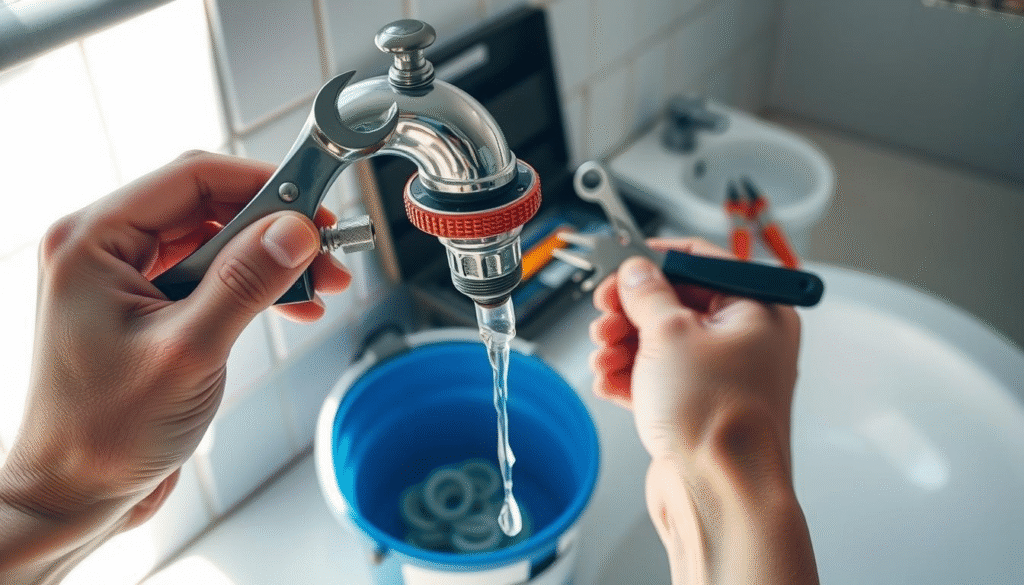
By considering the costs and your DIY comfort level, you can make a choice that fits your budget and plumbing needs.
Essential Tools and Materials for DIY Repair
Before starting your DIY faucet repair, make sure you have the right tools and materials. The right equipment makes the job easier and helps you do it right.
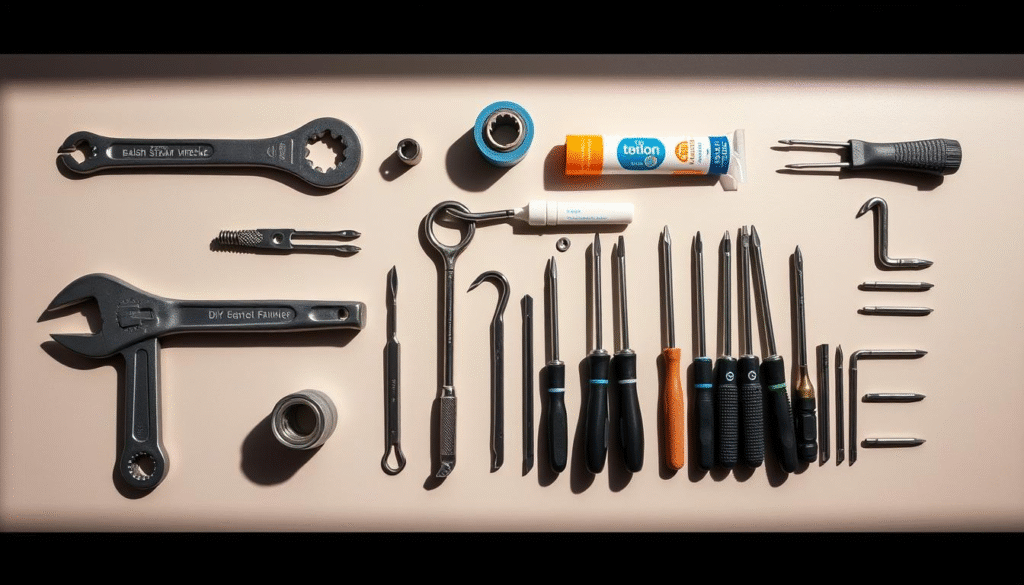
Basic Tool List with Prices
For DIY faucet repair, you’ll need screwdrivers, adjustable wrenches, and maybe a basin wrench. These tools help remove old parts. The cost varies, but a good screwdriver set is about $10-$20. An adjustable wrench can cost between $5-$15.
Replacement Parts and Their Costs
Parts like O-rings, washers, and valve seats are common for repairs. They’re usually affordable, with O-rings and washers costing $1-$5. Valve seats might cost more, from $5-$20, depending on the faucet.
Where to Purchase Quality Parts
You can find quality parts at local hardware stores, home improvement centers, or online. Make sure the parts fit your faucet model. Online stores often have detailed info to help you choose the right parts.
Fixing a leaky faucet yourself can save you money. Knowing the faucet leak repair cost and having the right tools and parts can be cheaper than hiring a plumber. It’s a smart choice for many homeowners.
Step-by-Step DIY Faucet Repair Guide
Fixing a leaky faucet is easier than you think. With the right tools and a bit of knowledge, you can save money and prevent water waste. DIY faucet repair is a cost-effective solution.
Preparing for the Repair
Before starting, prepare your workspace and understand the repair steps.
Shutting Off Water Supply
First, find the shut-off valves under the sink. Turn them clockwise to shut off the water. Open the faucet to drain the pipes.
Protecting Your Workspace
Cover your workspace with a cloth or plastic sheet. This protects it from water damage and catches any falling parts.
Organizing Parts
Have a container ready to store the parts you remove. This keeps them organized and prevents loss.
Disassembling the Faucet
Now, let’s take apart the faucet to find the leak source.
Removing Handles and Decorative Elements
Use a screwdriver to remove the handle screws. Then, gently pull off the handle. Remove any decorative caps or elements to access the parts underneath.
Accessing the Valve
You’ll need to remove more parts to get to the valve. This might involve removing a retaining clip or ring.
Removing Internal Components
Carefully remove the internal components, like the stem and O-ring. Inspect them for wear.
Identifying and Replacing Faulty Parts
Check the removed parts for wear or damage.
Common Wear Points
O-rings, washers, and valve seats often wear out. Replace these parts with new ones.
Cleaning Mineral Deposits
If you have hard water, mineral deposits might be causing the leak. Soak the parts in a vinegar and water mixture to clean them.
Installing New Components
After cleaning or replacing parts, install them in the reverse order they were removed.
Reassembling and Testing
Reassemble the faucet in the correct order and test it for leaks.
Proper Reassembly Sequence
Reassemble the faucet in the reverse order of disassembly. Make sure all parts are securely tightened.
Testing for Leaks
Turn on the water supply and check for leaks. Run both hot and cold water to test thoroughly.
Fixing a leaky faucet can save you a lot on your water bill. By following these steps, you can successfully repair your faucet and enjoy a leak-free experience.
When to Call a Professional Plumber
Knowing when to call a professional plumber can prevent bigger problems. Simple leaks might be fixed by you, but complex issues need a pro. This can save you money and hassle in the long run.
Signs of Complex Plumbing Issues
Do you have leaks that won’t stop, water damage, or strange noises from your faucet? These could mean a bigger problem. Ignoring these signs can lead to costly repairs down the line. For example, a leak might show a problem with the faucet’s inner workings or the plumbing system itself.
Cost-Benefit Analysis of Professional Help
Getting a professional plumber might seem expensive, but it’s often worth it. A professional can diagnose and fix the issue quickly, avoiding more damage and expensive fixes. The cost for a professional to fix a leaky faucet can be between $100 to $300. This depends on the problem’s complexity and where you live.
Finding and Vetting Qualified Plumbers
Finding a good plumber is key. Look for licenses, insurance, and customer reviews to make sure they’re trustworthy. You can also ask friends or family for recommendations if they’ve dealt with similar plumbing issues.
Preventive Maintenance to Avoid Future Leaks
Regular maintenance of your faucets can greatly reduce the chance of a leak. By being proactive, you can dodge the hassle and expense of fixing a leaky faucet.
Inspection Tips
Regular checks are key to spotting problems early. Look for signs like dripping, loose handles, or mineral buildup. Checking your faucets every few months can help you catch issues early.
Water Quality Solutions
The quality of your water affects your faucets. Hard water can cause mineral buildup, leading to leaks. Installing a water softener can help reduce mineral deposits and extend your faucets’ life.
Seasonal Maintenance
Seasons bring different challenges for your faucets. In winter, insulate exposed pipes to avoid freezing. In areas with hard water, clean your faucets more often to prevent mineral buildup.
Upgrading Fixtures
If your faucets are old or often break, it might be time for new ones. Modern faucets are built to last and work efficiently, saving you money on repairs.
| Maintenance Task | Frequency | Benefit |
| Inspect Faucets | Every 3 Months | Early detection of problems |
| Clean Mineral Buildup | Every 6 Months | Prevents leaks and keeps water flowing |
| Check Water Pressure | Annually | Reduces strain on faucets and pipes |
By following these tips, you can lower the risk of a leaky faucet and the repair costs. Regular checks, improving water quality, seasonal care, and upgrading fixtures are all important steps to keep your faucets in good shape.
Conclusion
Knowing how much it costs to fix a leaky faucet is key for homeowners. The average price is about $169. This shows the financial side of fixing a leaky faucet.
Fixing a leaky faucet quickly is smart and saves water. It also helps avoid damage to your home. This is good for your wallet and the planet.
Fixing a leaky faucet stops bigger problems like water damage and mold. These can cost a lot more to fix. By fixing it fast, you save money and avoid headaches.
Regular checks and maintenance can catch leaks early. This stops them from getting worse. It’s a smart move for your home.
Repairing a leaky faucet is more than just saving money. It’s about taking care of your home. For $169, you can save water and cut down on bills. “A stitch in time saves nine,” and fixing a leaky faucet is a wise choice for your home’s future.
Sources
For more information on leaky faucet repair costs and DIY guides, refer to the following reputable sources:
- HomeAdvisor: Leaky Faucet Repair Cost
- Yelp: Plumbing Services in the US
- This Old House: How to Fix a Leaky Faucet
These sources offer valuable insights and expert advice on leaky faucet repair. They help you make informed decisions for your plumbing needs.
FAQ
How much does it typically cost to fix a leaky faucet?
Fixing a leaky faucet can cost between $50 and $200. This depends on the faucet type, repair complexity, and plumber’s rates.
What are the most common causes of leaky faucets?
Leaky faucets often happen due to worn-out O-rings and washers. Corroded valve seats, loose parts, and water pressure issues also play a role.
Can I fix a leaky faucet myself, or do I need to hire a professional plumber?
You can fix a leaky faucet yourself if you’re handy and have the right tools. But, if it’s complex or you’re unsure, it’s safer to hire a pro.
How can I prevent future leaks in my faucets?
To prevent leaks, regularly check your faucets and maintain them. Improve water quality and do seasonal maintenance. Upgrading to better fixtures can also help.
What are the environmental concerns associated with leaky faucets?
Leaky faucets waste a lot of water. This can lead to water scarcity and higher water bills, harming the environment.
Are there any hidden costs associated with fixing a leaky faucet?
Yes, there can be hidden costs. These include extra repairs, replacement parts, and damage to areas around the leak if not fixed quickly.
How do regional price differences in the US affect the cost of fixing a leaky faucet?
Regional prices can change the cost of fixing a leaky faucet. This is due to differences in labor, materials, and plumber’s rates across the US.
What are the signs that indicate I need to call a professional plumber?
If you have multiple leaks, corroded pipes, or issues that won’t go away with DIY, it’s time to call a pro.
Can I use generic replacement parts for my faucet, or do I need to purchase brand-specific parts?
While generic parts are available, it’s best to use brand-specific parts. They ensure compatibility and better performance.
How can I find a qualified plumber to fix my leaky faucet?
Look for a qualified plumber by reading online reviews, asking for referrals, and checking their licenses and certifications.
